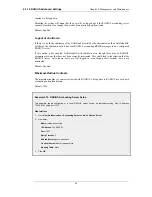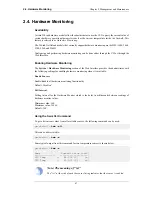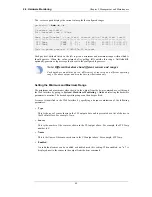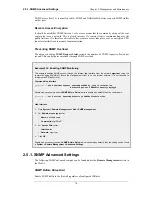
It is possible to have multiple pcapdump executions being performed at the same time. The
following points describe this feature:
1.
All capture from all executions goes to the same memory buffer.
The command can be launched multiple times with different interfaces specified. In this case
the packet flow for the different executions will be grouped together in different sections of the
report.
If a clearer picture of packets flowing between interfaces is required in the output then it is best
to issue one pcapdump command with the interfaces of interest specified.
2.
If no interface is specified then the capture is done on all interfaces.
3.
The -stop option without an interface specified will halt capture on all interfaces.
4.
pcapdump prevents capture running more than once on the same interface by detecting
command duplication.
Filter Expressions
Seeing all packets passing through a particular interface often provides an excess of information to
be useful. To focus on particular types of traffic the pcapdump command has the option to add an
filter expression which has one of the following forms:
-eth=<macaddr> - Filter on source or destination MAC address.
-ethsrc=<macaddr> - Filter on source MAC address.
-ethdest=<macaddr> - Filter on destination MAC address.
-ip=<ipaddr> - Filter source or destination IP address.
-ipsrc=<ipaddr> - Filter on source IP address.
-ipdest=<ipaddr> - Filter on destination IP address.
-port=<portnum> - Filter on source or destination port number.
-srcport=<portnum> - Filter on source port number.
-destport=<portnum> - Filter on destination port number.
-proto=<id> - Filter on protocol where id is the decimal protocol id.
-<protocolname> - Instead of the protocol number, the protocol name alone can be specified and
can be one of -tcp, -udp or -icmp.
Downloading the Output File
As shown in one of the examples above, the -write option of pcapdump can save buffered packet
information to a file on the NetDefend Firewall.
These output files are placed into the NetDefendOS root directory and the file name is specified in
the pcapdump command line, usually with a filetype of .cap. The name of output files must follow
certain rules which are described below. Files can then be downloaded to the local workstation using
Secure Copy (SCP) (see Section 2.1.6, “Secure Copy”). A list of all files in the NetDefendOS root
directory can be viewed by issuing the ls CLI command.
The -cleanup option will erase any saved pcapdump files (including any left over from earlier uses
of the command) so cleanup should only be done after file download is complete.
Note: NetDefendOS keeps track of saved files
NetDefendOS keeps track of all files created by pcapdump. This is true even between
system restarts so the -cleanup option is always able to delete all files from the
firewall's memory.
Output File Naming Restrictions
2.6. The pcapdump Command
Chapter 2. Management and Maintenance
73
Summary of Contents for DFL-1600 - Security Appliance
Page 27: ...1 3 NetDefendOS State Engine Packet Flow Chapter 1 NetDefendOS Overview 27 ...
Page 79: ...2 7 3 Restore to Factory Defaults Chapter 2 Management and Maintenance 79 ...
Page 146: ...3 9 DNS Chapter 3 Fundamentals 146 ...
Page 227: ...4 7 5 Advanced Settings for Transparent Mode Chapter 4 Routing 227 ...
Page 241: ...5 4 IP Pools Chapter 5 DHCP Services 241 ...
Page 339: ...6 7 Blacklisting Hosts and Networks Chapter 6 Security Mechanisms 339 ...
Page 360: ...7 4 7 SAT and FwdFast Rules Chapter 7 Address Translation 360 ...
Page 382: ...8 3 Customizing HTML Pages Chapter 8 User Authentication 382 ...
Page 386: ... The TLS ALG 9 1 5 The TLS Alternative for VPN Chapter 9 VPN 386 ...
Page 439: ...Figure 9 3 PPTP Client Usage 9 5 4 PPTP L2TP Clients Chapter 9 VPN 439 ...
Page 450: ...9 7 6 Specific Symptoms Chapter 9 VPN 450 ...
Page 488: ...10 4 6 Setting Up SLB_SAT Rules Chapter 10 Traffic Management 488 ...
Page 503: ...11 6 HA Advanced Settings Chapter 11 High Availability 503 ...
Page 510: ...12 3 5 Limitations Chapter 12 ZoneDefense 510 ...
Page 533: ...13 9 Miscellaneous Settings Chapter 13 Advanced Settings 533 ...



































